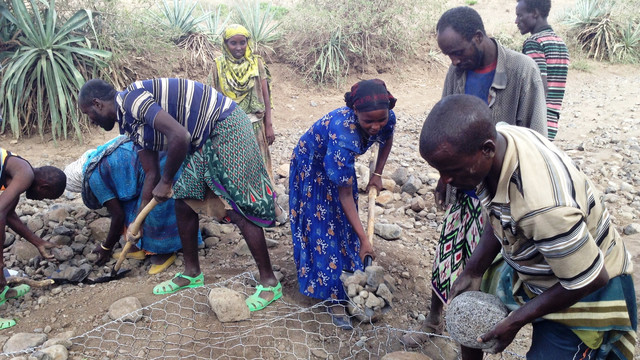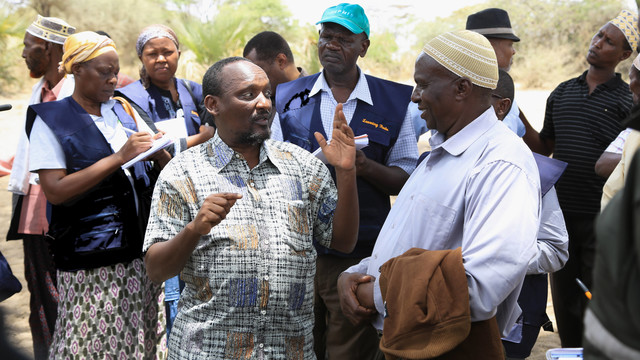Why we need to plug the adaptation technology gap
One of CBA12’s three workstreams will explore how new technologies can help local communities adapt to climate change. Guest blogger Chris Henderson discusses the possibilities around ‘new technology’.


Pastoral livelihoods in the drylands are facing climate challenges such as increasing temperatures and increased frequency of extreme weather events (Photo: Practical Action)
In a world where new technology is changing the way we live our lives, and constantly surprising us about what is possible, it is no wonder that we look to ‘new technology’ to provide solutions to the world’s most pressing issues.
The daunting task of taking the action needed to reduce emissions and build resilience to climate change – the mitigation and adaptation objectives of the Paris Agreement – is no exception.
Tech driving mitigation – but adaptation missing out
Huge strides in new technologies have significantly supported climate change mitigation. Commercial research, particularly around renewable energy, has created tremendous opportunity for nations to reduce their greenhouse gas emissions. Encouraged by market competition or regulation by governments, the private sector has been instrumental in improving the energy efficiency of engines, cars, planes, factories and homes.
The story is not the same for adaptation, with woefully inadequate finance and limited innovation. Here, we seem to be in search of ‘silver bullets’, with growing calls for the scientific community to deliver market-oriented and transferable adaptation technologies – or short-term technology ‘fixes’.
The ideal would be to mobilise the private sector to deliver innovations and resources to achieve adaptation at scale - as has been the case with mitigation.
How can adaptation technologies grow opportunities for small-scale farmers?
In developed countries, where commercial intensive agriculture is the norm and agricultural technology is more advanced, we can expect farmers and agricultural businesses to explore and develop technologies that enable the sector to adapt to the changing climate.
But these technologies are unlikely to be suited to, or accessible for, small-scale, risk averse farming families in poorer countries. If technologies are to meet the needs of these farming communities, they need to build on smallholders’ assets, be affordable, reliable (low risk), and work in the long term. Such technologies are most likely to be adopted and lead to adaptation at scale.
Adaptation technologies in practice

One of the areas we will explore under CBA12’s workstream ‘Innovation in applying adaptation technology’ is how people living in rural areas can use technologies to leverage the natural capital they already have – plants, animals, soils, water, forests, land – to make their communities more productive and resilient in the face of a changing climate.
For example, water and land use management technologies that integrate the needs and voices of all vested-interest groups – including groups within households, farmers, livestock owners and others.

We will look at how recent advances in renewable energy technologies – such as solar powered irrigation for crop production, or wind powered water points for livestock – have helped farmers cope with increasingly unpredictable weather and seasons, and helped households to store produce. Such solutions safeguard livelihoods and help keep local economies productive.
Adaptation technology also extends to how digital or communication technologies improve access to and use of knowledge, such as short- and medium-term weather forecasts. With more reliable predictions, farmers and traders can be more confident about supply and demand and prices. Digital devices and information could give farmers market updates, arming them with the information they need to strike better deals with traders.
Innovate with us at CBA12

At CBA12 we will be exploring how technology can enable locally-driven adaptation. What are the ‘hooks’ to attract farmers, communities, local enterprises and other private sector actors, and local, national and international governments, to invest in climate action?
We will aim to understand what characteristics and approaches ensure that technology does fit the local context – i.e. drives adaptation and does not inadvertently lead to the short-term gains that might lead to mal-adaption, resulting in loss of agricultural biodiversity, degraded soils, contaminated ground water, deforestation or erosion.
Together we will explore new and existing technologies that will work for poor and climate vulnerable communities and find workable ways forward for turning the growing calls for technology ’fixes’ into practical, accessible and affordable solutions that can mobilise investment and enable adaptation at scale.
CBA12 takes place in Lilongwe, Malawi from 11-14 June 2018.


